Image above: Portrait of Lori Nix by Andrea Blanch.
Andrea Blanch: When did you first start to make the elaborate models that are now the subjects?
Lori Nix: I started The Laundromat in 2005 and it is continuing. This time next year it will be a decade. Thats a long time for a project.
AB: Do you work on anything else?
LN: I work on all kinds of other projects, I have a black and white series I’ve been picking away at since 2009 called Unnatural History which spoofs The Natural History Museum. I was awarded a Guggenheim Fellowship so I’m starting that whole body of work. I wont see the results of it until 3 or 4 years from now because I work slowly. It’s just me and my partner Cathleen; we build pretty much everything.
AB: She helps you make the models?
LN: Absolutely.
AB: Why did you gravitate towards this method?
LN: Well I’m just that type of photographer. I’ve never been a photojournalist, I tried in college, I was horrible at it. Not interested in being a wedding photographer—not interested in that whole institution. I’m a bit of a home body, so I’m not going to be a travel photographer. I don’t have the personality to do fashion and commercial work; I have the personality to stay home and create environments instead. I have a degree in ceramics so working with my hands comes pretty naturally.
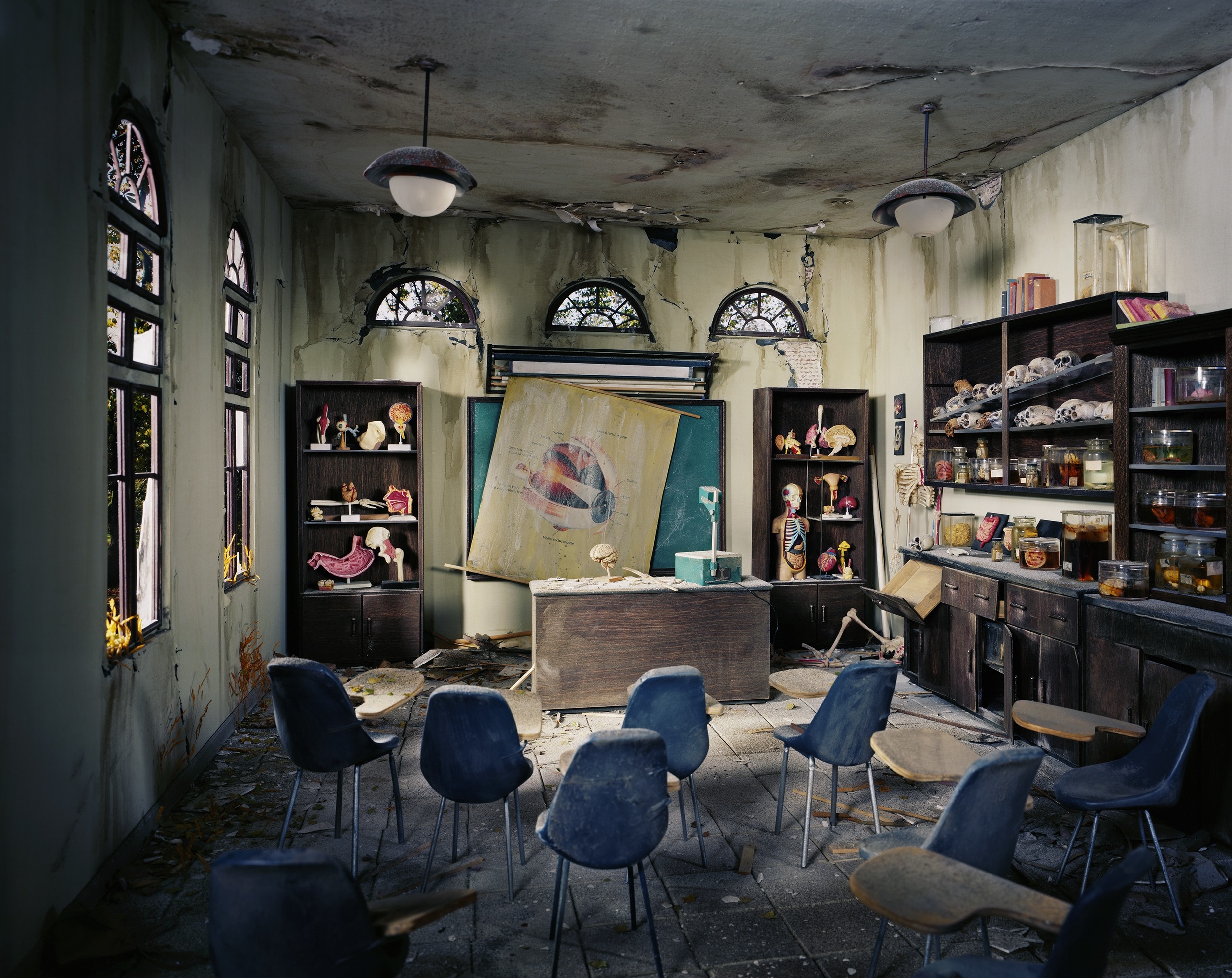 © Lori Nix, Anatomy Classroom, 2012.
© Lori Nix, Anatomy Classroom, 2012.
AB: What do you feel is the difference between creating your subject matter and finding it out in the world?
LN: Well you have more control for one thing, so you can direct exactly what the viewer is going to see. What’s interesting about these models is I only build them from one vantage point; that of the camera lens. If you take two steps to either side you will see the building materials I never finished. You will see hot glue and clamps and everything else. There is a type of photography that looks a lot like mine for urban explorers. It’s these people going into abandoned spaces all through U.S and E.U and photographing. Do I really want to be an urban explorer in New York City? No. I’m not a fan of rats or smelly places.
AB: Do you ever take a camera with you to take a picture and then interpret that into one of your sets?
LN: I have before, but very limited. I visited a person who owns a classical instrument, a violin, and viola auction house; he gave me a tour of his place with these instruments that will be going up for auction. The room where they repair them is the deep storage where they keep all their most precious Stradivarius. He gave me a tour of the whole facility and once I saw the room where the repair guy actually repairs them I could never see it any other way. I ended up doing it it exactly how I saw it in there. So, do I like to take my camera? No. Once I see something that already exists it’s really hard to see it in another way. I have the world’s worse camera phone, so that doesn’t help. I mean it’s the worst. Sometimes I have a point and shoot,but I forget to travel with it. As long as you have imagination thats all that really matters.
AB: How long does it take for one idea to become a photograph?
LN: Average is seven months. It can take anywhere from three months to fifteen. We worked on one for fifteen while we were working on others around it. We usually try to do two at the same time, right now there is only one going, but seven months is usually the time frame.
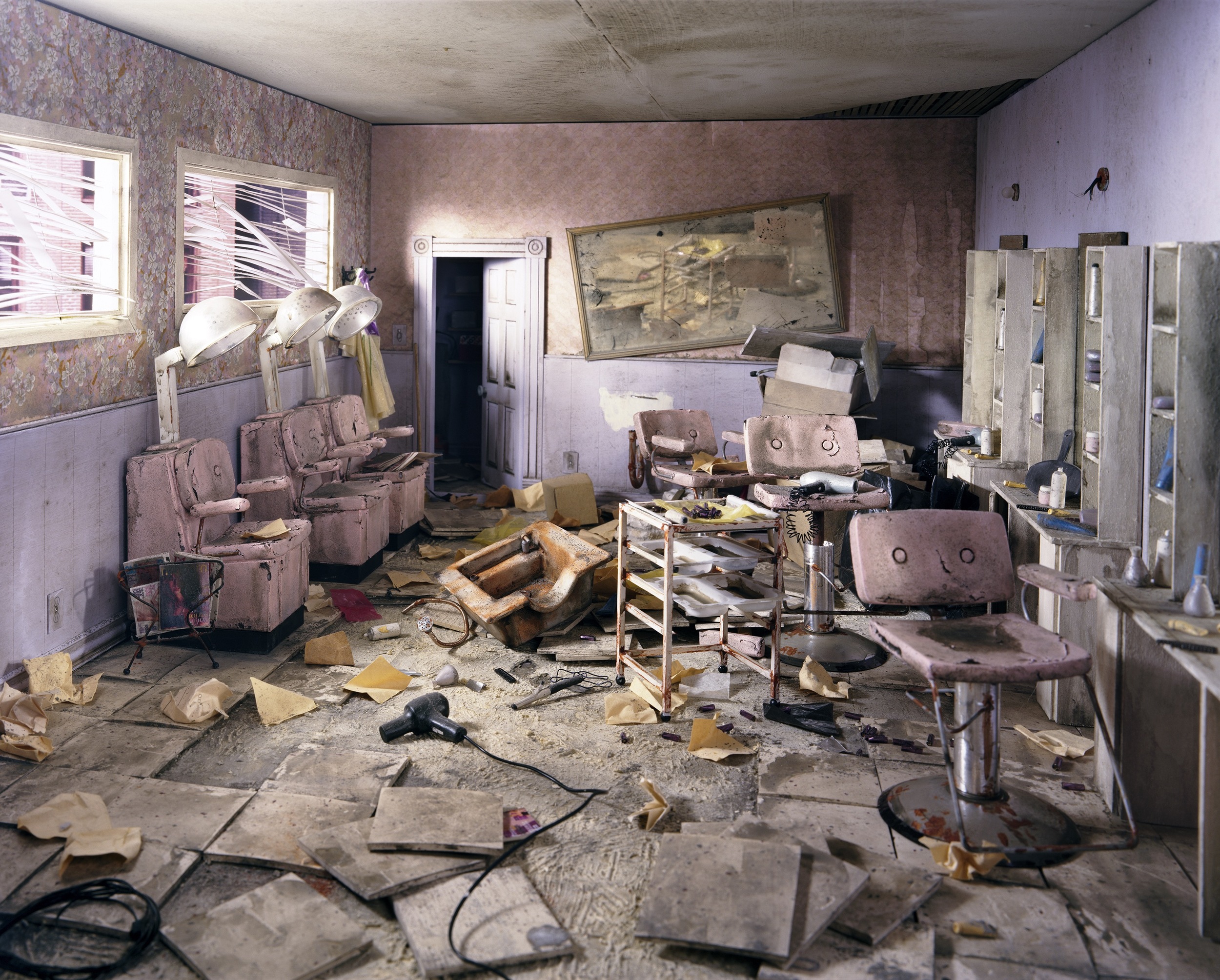 © Lori Nix, Beauty Shop, 2010.
© Lori Nix, Beauty Shop, 2010.
AB: What is involved in the production of the final Images?
LN: You mean all the materials? It’s just a long process. First come up with the idea, resource the materials; I love doing research online. I can find almost anything I need as far as building materials. Then sitting down with Cathleen we sketch out the view that the camera might take, we try to figure out the most dynamic space, you don’t want to keep making boxes over and over. You want walls and openings and then after that we just start building. I usually end up building the exterior walls, then once the exterior walls are made then the objects start coming. That’s when it takes the longest; building the furniture and putting in the details.
AB: Do you use a large format?
LN: Yeah 8x10
AB: Did you always use that camera?
LN: For the city series, yes, for the other series I do 4x5. Rarely do I go below that, for commercial work I’ll use a Canon 5d.
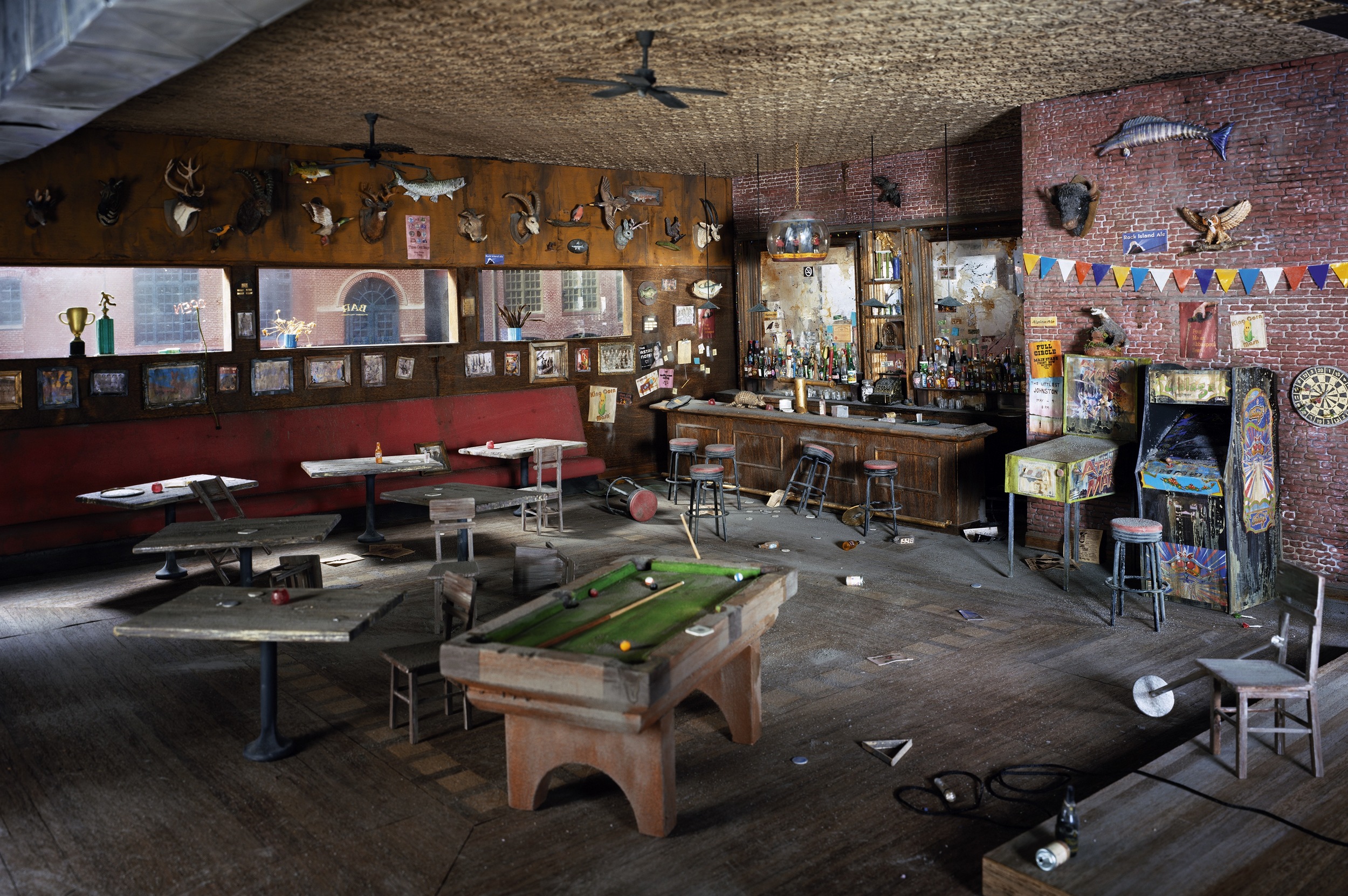 © Lori Nix, Bar, 2009.
© Lori Nix, Bar, 2009.
AB: What’s the proportion of your set to reality?
LN: They are bigger than you imagine but definitely smaller than real life. We usually work probably one to six. That scale is the most comfortable, so the figure stands about anywhere from eight to ten inches high. That makes for a very large scene. One of our scenes, The Mall, ended up being ten feet wide and nine feet deep. It was a little too big because it was a three story structure and it just kept going on and on and on.
AB: Do you get attached to these?
LN: No, no problem. I cannot wait to take them down; to decommission them. I just decommissioned one about three weeks ago no problem whatsoever. It just means I’m clearing the table ready for the next scene.
AB: Are your photographs your final product or are the dioramas just as important?
LN: The photograph is the final product. People ask if I ever show the dioramas, I have on two occasions, but they were museum shows about diorama. What was interesting was the first show, at The Museum of Arts and Design, was otherworldly. Everyone in the world who works in miniature and diorama either for video for instillation inside a wall, or a photograph, and I happened to work for the photograph. I was very nervous showing the diorama. I had never finished all the way round. The curator said thats fine this is how you work, it’s your working process. So [the visitor] saw pink and blue foam everywhere.The second time was at The Bruce Museum in Connecticut, and they built a bonnet around it so you couldn’t see the pink foam, they finished it off into a very nice object which I though was interesting.
AB: Do they sell for more than the photographs?
LN: Oh I never sell them. No one has ever asked to buy them and I don’t build them to exist forever. I don’t want to think about archival materials, and I don’t want to think about if this wall comes unglued in ten years; I don’t even offer them for sale.
AB: Whats your attraction to apocalyptic scenarios?
LN: Well I grew up in Western Kansas. Does that say everything right there? So my whole childhood is defined by tornado, flood, hailstorms, blizzards, insect infestations. Although, these things are actually happening where we live in Brooklyn. I was at my favorite bar and a tornado had just hit. I was like ‘where is my bartender’ and he was out in the street pulling out tree branches. Something is wrong. It’s just wrong. Something is wrong with this world.
AB: Big time
LN: So it comes natural for me to like bad bad weather.
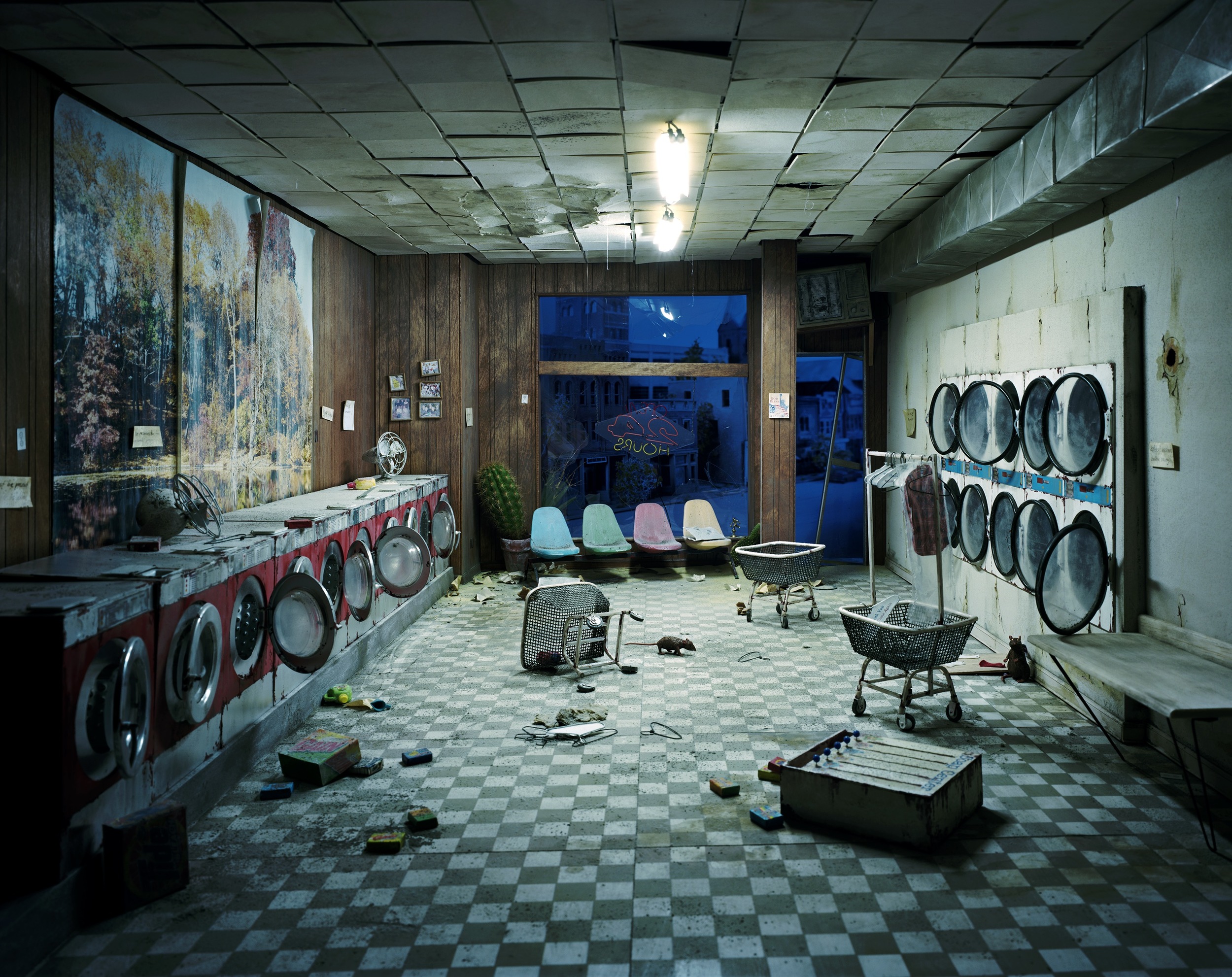 © Lori Nix, Laundromat at night, 2008.
© Lori Nix, Laundromat at night, 2008.
AB: You undergo a process of creation that results in scenes of destruction. Is this purposefully ironic?
LN: What is the definition of irony? I’m not trying to be ironic—these are serious, but at the same time there are kind of funny things about them. I’m not poking fun at the fact that we are heading towards are own demise, I’m kind of worried. I’m glad I don’t have kids I’m going to raise into this world.
AB: What emotions do you hope to evoke in your photograph?
LN: Thats a good question. I don’t know: wonder and dread at the same time, awe and dread. Like; “Ahh!” First I want people be excited to see the work, but then when they think about what it is; that this could be New York City in 10 years 20 years 50 years. I always position myself the photographer as the last person alive in this city and I’m just walking around seeing all these spaces. Thats why you don’t see any zombies, there is no Zombie Apocalypse, just the city, there is no Will Smith, there are no rabid dogs. There is just me and gravel.
AB: Never had the desire to photograph people?
LN: Not in this series, because everyone is gone.
AB: Are you ever going to?
LN: The next body of work I’m working figuratively, but they are not going to be pictures of people. They are going to be photographs of models, we are attempting to make the human form. It’s really interesting and kind of hard.
AB: Your partner works with you on these. Does she get credit with you?
LN: She gets credit when I talk to everyone, everyone knows she’s a big part of this. With the next body of work her name is going to be on it. Like Christo went on to be Christo and Jeanne-Claude. It’s time, because she is a big part of it.
AB: Any suggestions for people that want to get a Guggenheim?
LN: Know it’s not Impossible. Because I won one doesn’t make me an expert. I have no idea what the search committee is looking for. One recipient applied eight times and just keeps applying, but the people who are on the selection committee change every year, I do believe. I’m not for sure because no one would tell me. I couldn’t get any information out of any of the Guggenheim people whatsoever.
AB: Do you have a daily ritual outside of your photographic work?
LN: I don’t have a day job any more, I am 100% freelance so my new daily ritual is actually going for a walk or exercising in some capacity just to get myself up and around. So, walking through Prospect Park is now my daily ritual.
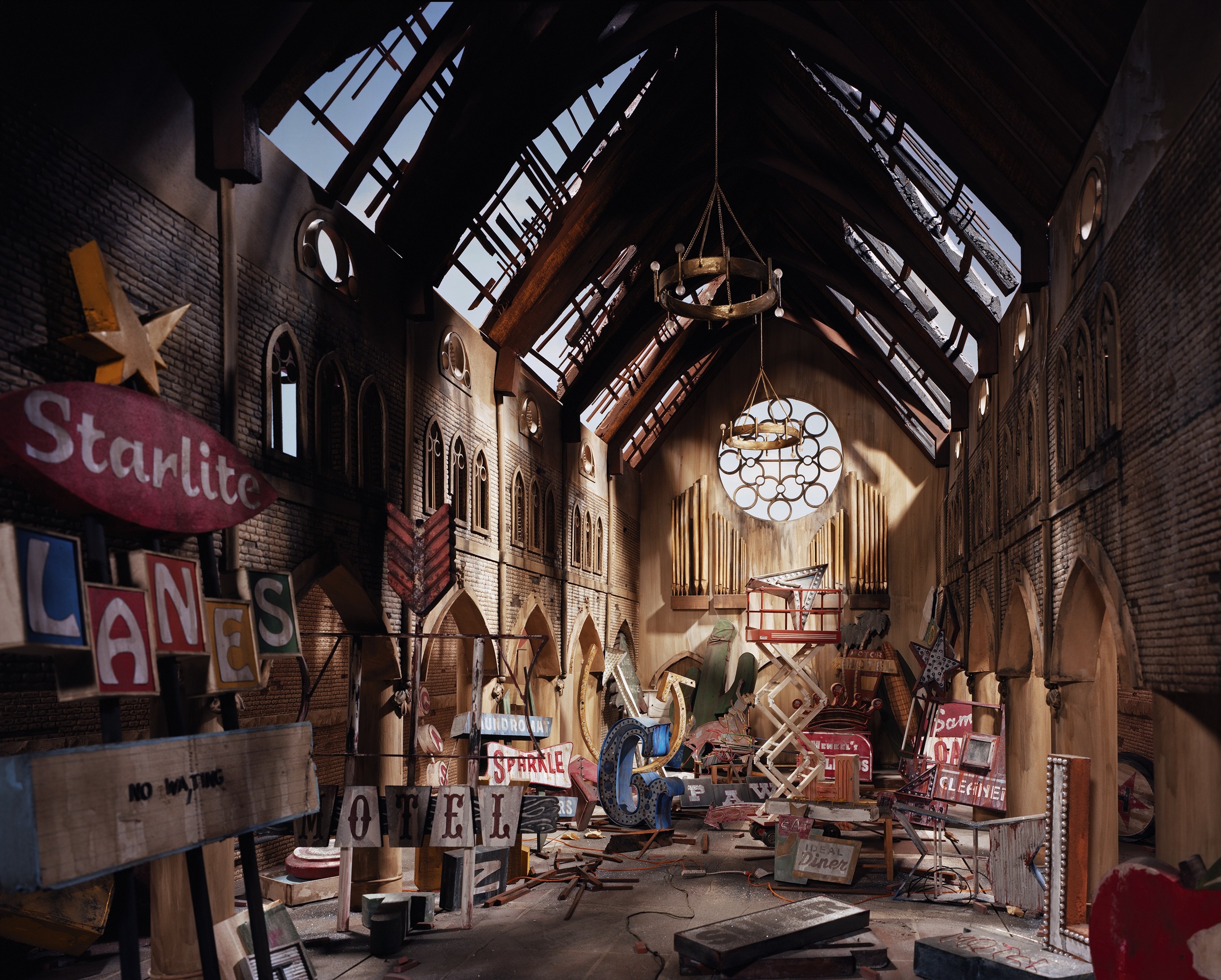 © Lori Nix, Church, 2009.
© Lori Nix, Church, 2009.
All images courtesy of the artist and ClampArt Gallery.


